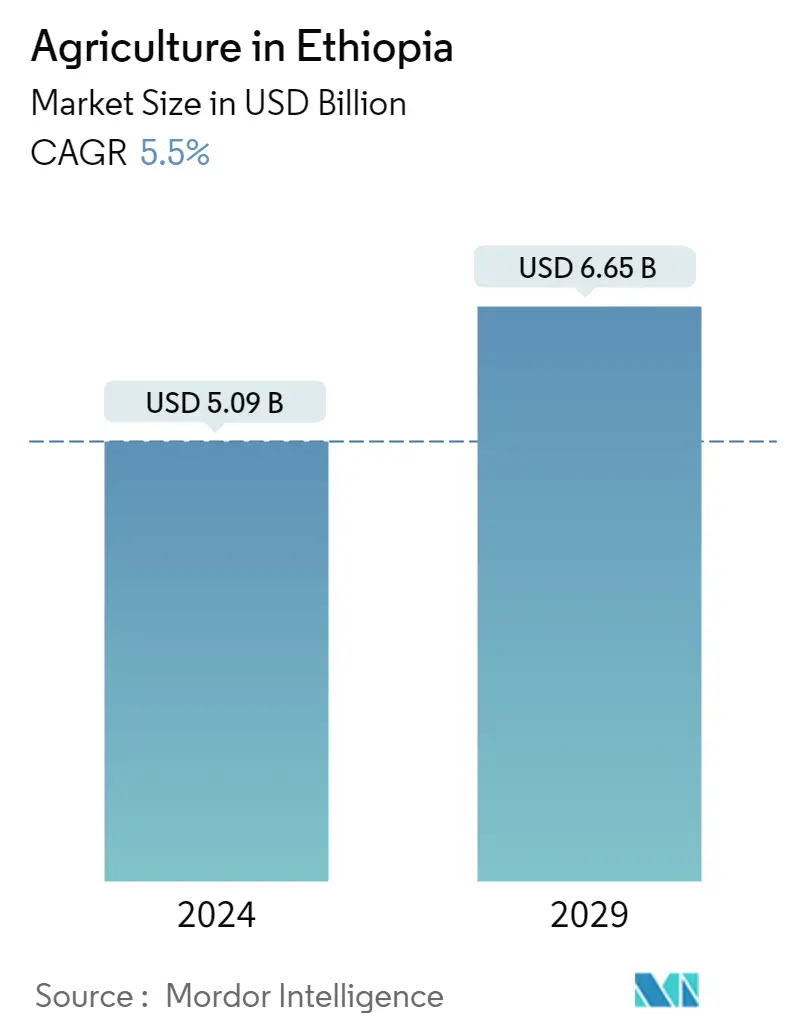Market Size of Agriculture in Ethiopia

| Study Period | 2019 - 2029 |
| Base Year For Estimation | 2023 |
| Forecast Data Period | 2024 - 2029 |
| Market Size (2024) | USD 5.09 Billion |
| Market Size (2029) | USD 6.65 Billion |
| CAGR (2024 - 2029) | 5.50 % |
Need a report that reflects how COVID-19 has impacted this market and its growth?
Ethiopian Agriculture Market Analysis
The Agriculture in Ethiopia Market size is estimated at USD 5.09 billion in 2024, and is expected to reach USD 6.65 billion by 2029, growing at a CAGR of 5.5% during the forecast period (2024-2029).
- Agriculture is the largest component of the Ethiopian economy, accounting for 40% of GDP, 80% of exports, and employs about 75% of the country's workforce. The agriculture sector of the country is affected by factors such as weak market linkages and limited use of inputs such as improved seeds, fertilizers, pesticides, etc. Despite numerous challenges, the country has ample opportunities in the commercialization of fruit, vegetable, and ornamental plant productions owing to its proximity to the Middle Eastern nations. The favorable government policies encouraging the private sector and the advantageous agro-climatic conditions are the two major drivers of the market's growth.
- Smallholder farmers having less than one hectare of land constitute the major farming section of the country as they are responsible for over 95% of the agriculture production. The majority of these farmers are engaged in cereal production, which is the major staple food for people in Ethiopia. Along with cereals production, the growth of the livestock feed sector is also rising as the country hosts one of the largest livestock populations in Africa with 50 million cattle, 50 million goats and sheep, camels, chickens, etc.
- The government's efforts to become a net exporter of agricultural products is one of the major factors responsible for the growth of the agriculture sector in the country.
Ethiopian Agriculture Industry Segmentation
Agriculture in Ethiopia involves the production of various food crops, fruits, and vegetable crops in the country. Major crops in the country include coffee, pulses, sugarcane, potatoes, maize, sugarcane, etc.
The market for agriculture in Ethiopia is segmented by type (food crops, fruits, and vegetables). The report includes the production analysis (volume), consumption analysis (value and volume), export analysis (value and volume), import analysis (value and volume), and price trend analysis. The report offers the market size and forecast by volume (metric ton) and value (USD thousand) for the above segments.
| By Type | |
| Food Crops | |
| Fruits | |
| Vegetables |
Agriculture in Ethiopia Size Summary
The Ethiopian Agriculture Market is experiencing significant growth, largely driven by the sector's dominant role within the country's economy. Agriculture is the largest component of the Ethiopian economy, contributing to a significant portion of the GDP, exports, and employment. Despite facing challenges such as weak market linkages and limited use of inputs, the sector has ample opportunities for growth, particularly in the commercialization of fruit, vegetable, and ornamental plant productions. The market's growth is further enhanced by favorable government policies and advantageous agro-climatic conditions. The Ethiopian government has been proactive in its efforts to develop the agriculture sector, with initiatives aimed at expanding primary and processed agricultural products. The government's focus on increasing the productivity of smallholder farms and expanding large-scale commercial farms has been key to this development. The establishment of the Agricultural Transformation Agency (ATA) is a testament to the government's commitment to transforming smallholder farmers into commercialized players with high incomes. Furthermore, the government's 10-year economic development plan prioritizes agriculture, with strategic pillars aimed at enhancing agricultural production and productivity. This focus on agriculture development, coupled with increasing cereal production in the country, is expected to continue driving the growth of the agriculture sector in Ethiopia.
Explore MoreAgriculture in Ethiopia Market Size - Table of Contents
-
1. MARKET DYNAMICS
-
1.1 Market Overview
-
1.2 Market Drivers
-
1.3 Market Restraints
-
-
2. MARKET SEGMENTATION
-
2.1 By Type
-
2.1.1 Food Crops
-
2.1.2 Fruits
-
2.1.3 Vegetables
-
-
Agriculture in Ethiopia Market Size FAQs
How big is the Agriculture in Ethiopia Market?
The Agriculture in Ethiopia Market size is expected to reach USD 5.09 billion in 2024 and grow at a CAGR of 5.5% to reach USD 6.65 billion by 2029.
What is the current Agriculture in Ethiopia Market size?
In 2024, the Agriculture in Ethiopia Market size is expected to reach USD 5.09 billion.
